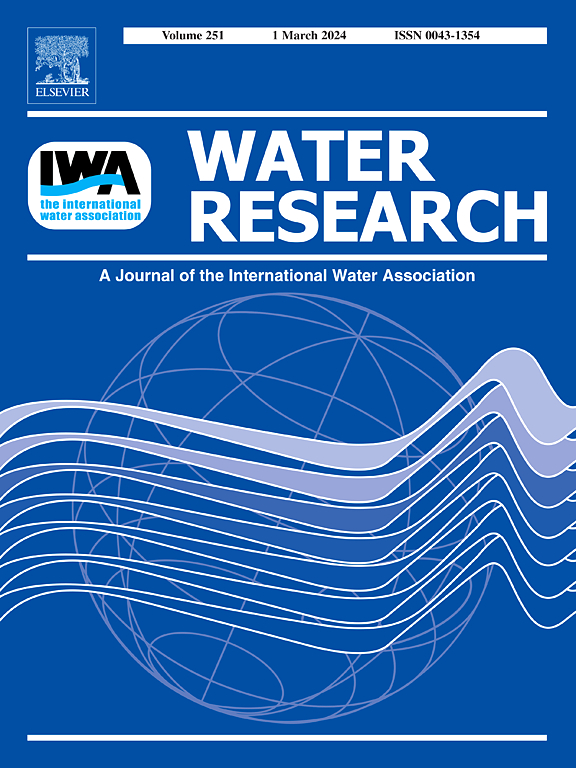Role of temperature on the cytotoxicity of drinking water upon chlorination in the presence of CuO
IF 12.4
1区 环境科学与生态学
Q1 ENGINEERING, ENVIRONMENTAL
引用次数: 0
Abstract
Average temperatures are growing globally with climate change, which in turn increases water temperatures in distribution systems. Cupric oxide (CuO), a pipe corrosion product, has been reported to enhance the formation of disinfection byproducts (DBPs) in drinking water at ambient room temperature. The influence of water temperature on the DBP-associated mammalian cell cytotoxicity of chlorinated drinking waters in the presence of CuO was investigated in this study. Results showed that the presence of CuO increased the Chinese hamster ovary cell cytotoxicity of chlorinated drinking water, irrespective of temperature. However, increasing the temperature from 20 to 60 °C decreased the bioassay-based measured cytotoxicity caused by nonvolatile fractions, albeit a slight increase in the calculated additive cytotoxicity from (semi-)volatile known DBPs. Therefore, the contribution from the latter one to total cytotoxicity increased from 21 % to 48 % in the presence of CuO when the temperature increased from 20 to 60 °C. Using Fourier transform ion cyclotron resonance mass spectrometry, ratios of Cl/C and Br/C in the identified formulas from nonvolatile fractions were positively correlated with cytotoxicity. The presence of CuO decreased carbon number but increased O/C and Br/C of formulas. Yet, the CuO-induced promoting effects decreased by 4–13 % at 60 °C compared with 20 °C. Structures of 24 halogenated DBPs were deciphered, including 3 aliphatic, 4 alicyclic and 17 aromatic substances. Despite the reduction in cytotoxicity of nonvolatile fractions at relatively high water temperature, promoting effects of CuO and heat on volatile DBP exposure risks should also be taken into consideration. This work provides insights into the role of temperature on water cytotoxicity in copper-containing distribution systems and household plumbing.


温度对氯化后饮用水细胞毒性的影响
随着气候变化,全球平均气温正在上升,这反过来又提高了供水系统的水温。氧化铜(CuO)是一种管道腐蚀产物,据报道在室温环境下可促进饮用水中消毒副产物(DBPs)的形成。本研究探讨了水温对氯化饮用水中存在CuO时dbps相关哺乳动物细胞毒性的影响。结果表明,CuO的存在增加了水细胞毒性,与温度无关。然而,将温度从20°C提高到60°C,尽管挥发性dbp的细胞毒性略有增加,但由于非挥发性组分引起的细胞毒性急剧下降,总细胞毒性降低了约45%。因此,当CuO存在时,当温度从20℃升高到60℃时,后者对总细胞毒性的贡献从21%增加到48%。利用傅里叶变换离子回旋共振质谱法,鉴定出的非挥发性组分中Cl/C和Br/C的比值与细胞毒性呈正相关。CuO的存在降低了配方的碳数,提高了配方的O/C和Br/C。然而,与20℃相比,60℃时cuo诱导的促进作用降低了4-13%。破译了24个卤化DBPs的结构,包括3个脂肪族物质,4个脂环物质和17个芳香物质。尽管在相对较高的水温下,非挥发性组分的细胞毒性降低,但CuO和热量对挥发性DBP暴露风险的促进作用也应考虑在内。这项工作为含铜配电系统和家庭管道中温度对水细胞毒性的作用提供了见解。
本文章由计算机程序翻译,如有差异,请以英文原文为准。
求助全文
约1分钟内获得全文
求助全文
来源期刊

Water Research
环境科学-工程:环境
CiteScore
20.80
自引率
9.40%
发文量
1307
审稿时长
38 days
期刊介绍:
Water Research, along with its open access companion journal Water Research X, serves as a platform for publishing original research papers covering various aspects of the science and technology related to the anthropogenic water cycle, water quality, and its management worldwide. The audience targeted by the journal comprises biologists, chemical engineers, chemists, civil engineers, environmental engineers, limnologists, and microbiologists. The scope of the journal include:
•Treatment processes for water and wastewaters (municipal, agricultural, industrial, and on-site treatment), including resource recovery and residuals management;
•Urban hydrology including sewer systems, stormwater management, and green infrastructure;
•Drinking water treatment and distribution;
•Potable and non-potable water reuse;
•Sanitation, public health, and risk assessment;
•Anaerobic digestion, solid and hazardous waste management, including source characterization and the effects and control of leachates and gaseous emissions;
•Contaminants (chemical, microbial, anthropogenic particles such as nanoparticles or microplastics) and related water quality sensing, monitoring, fate, and assessment;
•Anthropogenic impacts on inland, tidal, coastal and urban waters, focusing on surface and ground waters, and point and non-point sources of pollution;
•Environmental restoration, linked to surface water, groundwater and groundwater remediation;
•Analysis of the interfaces between sediments and water, and between water and atmosphere, focusing specifically on anthropogenic impacts;
•Mathematical modelling, systems analysis, machine learning, and beneficial use of big data related to the anthropogenic water cycle;
•Socio-economic, policy, and regulations studies.
 求助内容:
求助内容: 应助结果提醒方式:
应助结果提醒方式:


